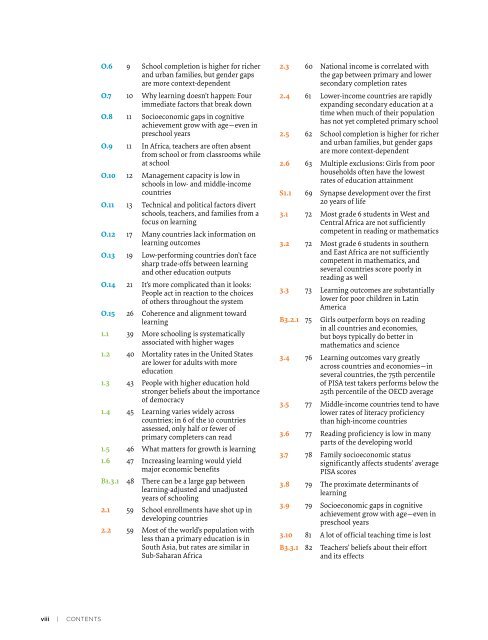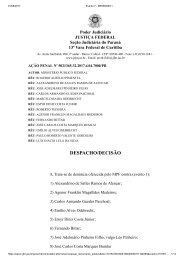Brasil só deve dominar Leitura em 260 anos, aponta estudo do Banco Mundial Relatorio Banco Mundial _Learning
Create successful ePaper yourself
Turn your PDF publications into a flip-book with our unique Google optimized e-Paper software.
O.6 9 School completion is higher for richer<br />
and urban families, but gender gaps<br />
are more context-dependent<br />
O.7 10 Why learning <strong>do</strong>esn’t happen: Four<br />
immediate factors that break <strong>do</strong>wn<br />
O.8 11 Socioeconomic gaps in cognitive<br />
achiev<strong>em</strong>ent grow with age—even in<br />
preschool years<br />
O.9 11 In Africa, teachers are often absent<br />
from school or from classrooms while<br />
at school<br />
O.10 12 Manag<strong>em</strong>ent capacity is low in<br />
schools in low- and middle-income<br />
countries<br />
O.11 13 Technical and political factors divert<br />
schools, teachers, and families from a<br />
focus on learning<br />
O.12 17 Many countries lack information on<br />
learning outcomes<br />
O.13 19 Low-performing countries <strong>do</strong>n’t face<br />
sharp trade-offs between learning<br />
and other education outputs<br />
O.14 21 It’s more complicated than it looks:<br />
People act in reaction to the choices<br />
of others throughout the syst<strong>em</strong><br />
O.15 26 Coherence and alignment toward<br />
learning<br />
1.1 39 More schooling is syst<strong>em</strong>atically<br />
associated with higher wages<br />
1.2 40 Mortality rates in the United States<br />
are lower for adults with more<br />
education<br />
1.3 43 People with higher education hold<br />
stronger beliefs about the importance<br />
of d<strong>em</strong>ocracy<br />
1.4 45 <strong>Learning</strong> varies widely across<br />
countries; in 6 of the 10 countries<br />
assessed, only half or fewer of<br />
primary completers can read<br />
1.5 46 What matters for growth is learning<br />
1.6 47 Increasing learning would yield<br />
major economic benefits<br />
B1.3.1 48 There can be a large gap between<br />
learning-adjusted and unadjusted<br />
years of schooling<br />
2.1 59 School enrollments have shot up in<br />
<strong>deve</strong>loping countries<br />
2.2 59 Most of the world’s population with<br />
less than a primary education is in<br />
South Asia, but rates are similar in<br />
Sub-Saharan Africa<br />
2.3 60 National income is correlated with<br />
the gap between primary and lower<br />
secondary completion rates<br />
2.4 61 Lower-income countries are rapidly<br />
expanding secondary education at a<br />
time when much of their population<br />
has not yet completed primary school<br />
2.5 62 School completion is higher for richer<br />
and urban families, but gender gaps<br />
are more context-dependent<br />
2.6 63 Multiple exclusions: Girls from poor<br />
households often have the lowest<br />
rates of education attainment<br />
S1.1 69 Synapse <strong>deve</strong>lopment over the first<br />
20 years of life<br />
3.1 72 Most grade 6 students in West and<br />
Central Africa are not sufficiently<br />
competent in reading or math<strong>em</strong>atics<br />
3.2 72 Most grade 6 students in southern<br />
and East Africa are not sufficiently<br />
competent in math<strong>em</strong>atics, and<br />
several countries score poorly in<br />
reading as well<br />
3.3 73 <strong>Learning</strong> outcomes are substantially<br />
lower for poor children in Latin<br />
America<br />
B3.2.1 75 Girls outperform boys on reading<br />
in all countries and economies,<br />
but boys typically <strong>do</strong> better in<br />
math<strong>em</strong>atics and science<br />
3.4 76 <strong>Learning</strong> outcomes vary greatly<br />
across countries and economies—in<br />
several countries, the 75th percentile<br />
of PISA test takers performs below the<br />
25th percentile of the OECD average<br />
3.5 77 Middle-income countries tend to have<br />
lower rates of literacy proficiency<br />
than high-income countries<br />
3.6 77 Reading proficiency is low in many<br />
parts of the <strong>deve</strong>loping world<br />
3.7 78 Family socioeconomic status<br />
significantly affects students’ average<br />
PISA scores<br />
3.8 79 The proximate determinants of<br />
learning<br />
3.9 79 Socioeconomic gaps in cognitive<br />
achiev<strong>em</strong>ent grow with age—even in<br />
preschool years<br />
3.10 81 A lot of official teaching time is lost<br />
B3.3.1 82 Teachers’ beliefs about their effort<br />
and its effects<br />
viii | CONTENTS








